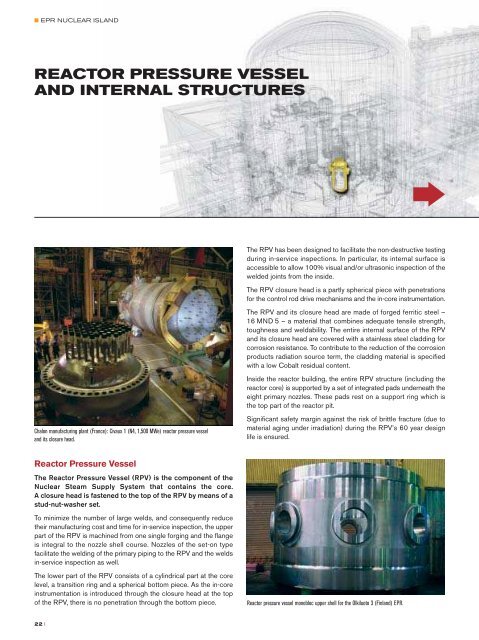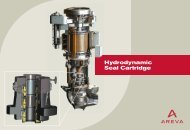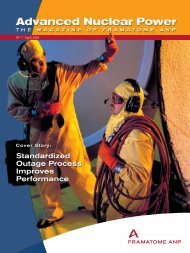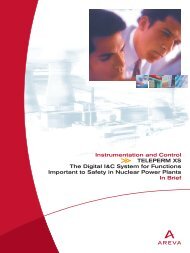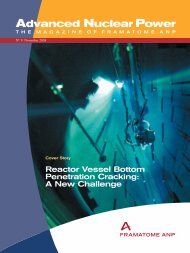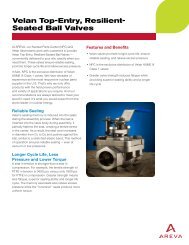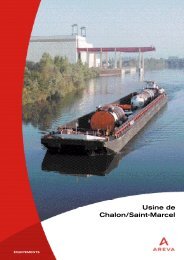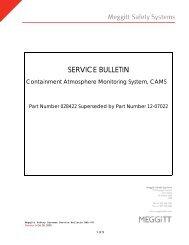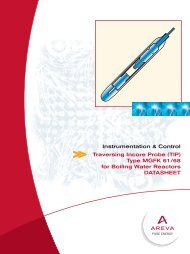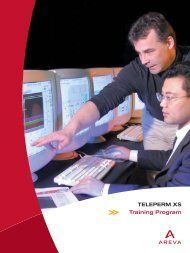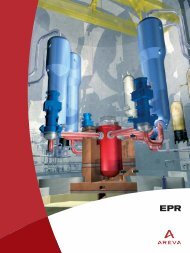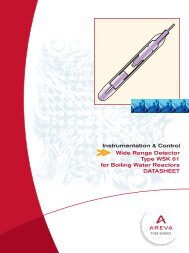Areva EPR
Areva EPR
Areva EPR
You also want an ePaper? Increase the reach of your titles
YUMPU automatically turns print PDFs into web optimized ePapers that Google loves.
■ <strong>EPR</strong> NUCLEAR ISLAND<br />
Instrumentation (level 0)<br />
A number of instrumentation channels supply measured data for<br />
control, surveillance and protection systems and for information of the<br />
control room staff. Multiple-channel acquisition is used for important<br />
controls such as control of pressure and temperature of the primary<br />
coolant, liquid level in the reactor pressure vessel. Multiple-channel<br />
and diversified data acquisition means are implemented.<br />
Aeroball system<br />
Carrier gas<br />
Concerning the protection of the reactor, a major aspect is the<br />
capacity to predict and measure the nuclear power (or neutron flux)<br />
level and the three dimensional distribution of power in the core.<br />
Ball guide tube<br />
The measurement of the power level is performed using ex-core<br />
instrumentation which also provides signals to monitor the core<br />
criticality. Relying on temperature measurements in the cold and hot<br />
legs of the four primary loops, a quadruple-redundant primary heat<br />
balance is achieved and complemented by neutron flux measurements<br />
with very short response time.<br />
Prediction and measurement of the three-dimensional power<br />
distribution relies on two types of in-core instrumentation:<br />
• “movable” reference instrumentation to validate the core design<br />
and to calibrate the other sensors utilized for core surveillance and<br />
protection purposes,<br />
• “fixed” instrumentation to deliver online information to the<br />
surveillance and protection systems which actuate appropriate<br />
actions and countermeasures in case of anomalies or exceeding<br />
of predefined limits.<br />
The movable reference instrumentation for power distribution<br />
assessment is an “aeroball” system. Stacks of vanadium-alloy balls,<br />
inserted from the top of the pressure vessel, are pneumatically<br />
transported into the reactor core (inside guide thimbles of fuel<br />
assemblies), then, after three minutes in the core, to a bench where the<br />
activation of each probe is measured at 30 positions in five minutes.<br />
This gives values of the local neutron flux in the core, which are<br />
processed to construct the three-dimensional power distribution map.<br />
The fixed in-core instrumentation consists of neutron detectors<br />
and thermocouples to measure the neutron flux radial and axial<br />
distribution in the core and temperature radial distribution at the core<br />
outlet. The neutron flux signals are utilized to control the axial power<br />
distribution, and for core surveillance and protection. The core outlet<br />
thermocouples continuously measure the fuel assembly outlet<br />
temperature and provide signals for core monitoring in case of loss<br />
of coolant event. They also provide information on radial power<br />
distribution and thermal-hydraulic local conditions.<br />
A<br />
Shroud<br />
Steel balls<br />
Ball stop<br />
Active core height<br />
<strong>EPR</strong> in-core instrumentation<br />
B C D E F G H J K L M N P R S T<br />
17<br />
16<br />
15<br />
14<br />
13<br />
12<br />
11<br />
10<br />
9<br />
8<br />
7<br />
6<br />
5<br />
4<br />
3<br />
2<br />
1<br />
241 Fuel assemblies<br />
89 Control rods<br />
12 In-core detectors<br />
40 Aeroball probes<br />
12 Instrumentation<br />
lance yokes<br />
42 I


